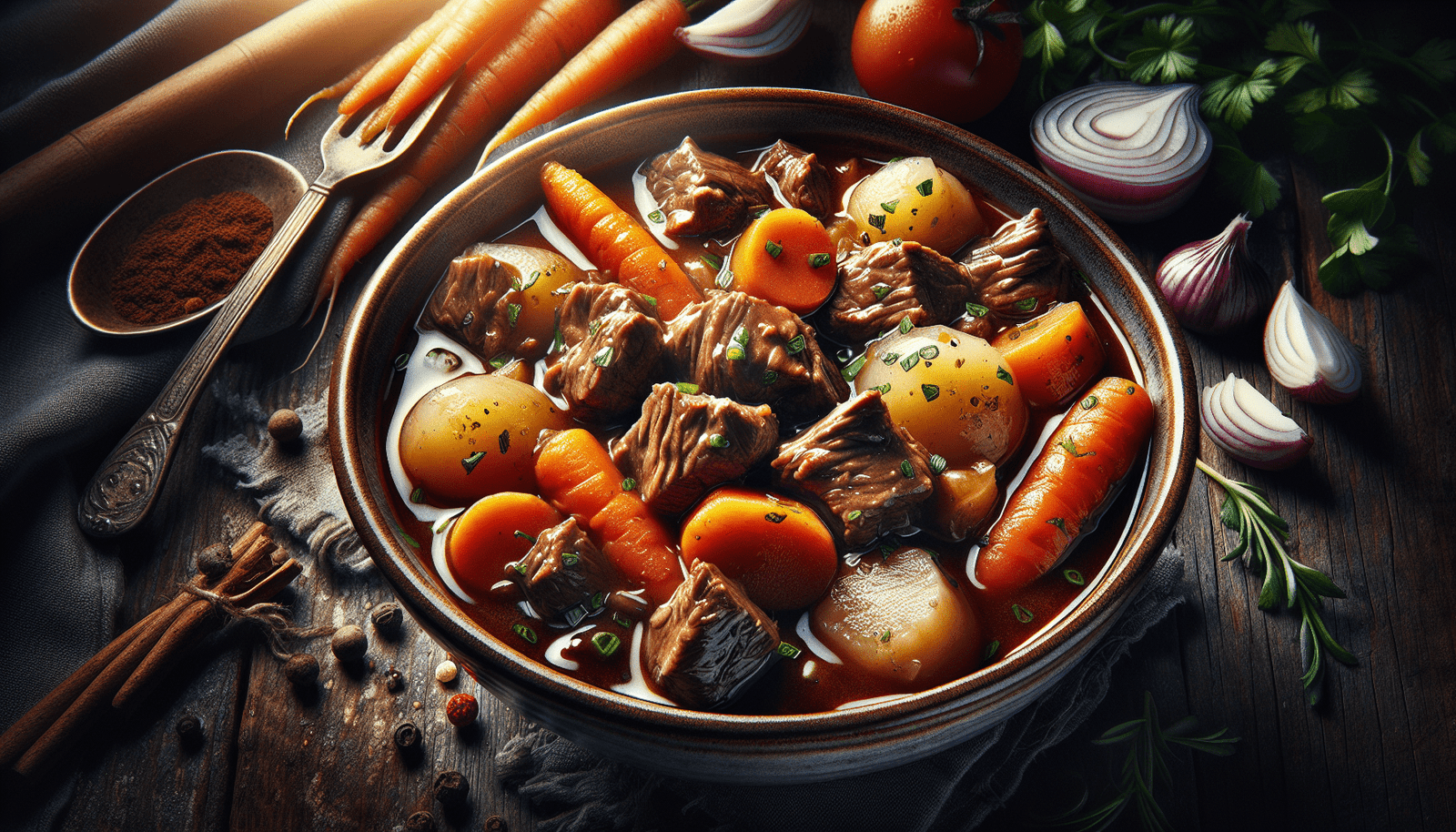I must admit, there’s nothing quite like a warm, hearty meal on a chilly evening, and when it comes to comfort food, a delicious beef stew tops my list. Packed with tender chunks of beef, hearty vegetables, and a savory broth, this dish never fails to satisfy both my taste buds and my soul. But what takes this beef stew to the next level is the use of fresh ingredients. From vibrant carrots and aromatic herbs to rich tomatoes and flavorful spices, each element adds a burst of flavor and a touch of freshness that elevates this classic dish to new heights. So, if you’re looking to savor the comforting embrace of a steaming bowl of beef stew, join me as we explore the world of deliciousness that comes with using fresh ingredients.
Overview of Beef Stew
Beef stew is a hearty and comforting dish that has been enjoyed by people all over the world for centuries. It is a flavorful and satisfying meal that combines tender cuts of beef with an assortment of vegetables and aromatic ingredients. Whether it’s a classic traditional recipe or a unique and gourmet twist, beef stew offers endless possibilities for culinary creativity. In this article, I will take you on a journey exploring the history, types, and popularity of beef stew. We will also delve into selecting the right beef, essential ingredients, preparation and cooking techniques, recipe variations, serving suggestions, tips and tricks, health benefits, and how to enjoy beef stew year-round.
What is Beef Stew?
Beef stew is a savory dish that features beef as the star ingredient. It typically consists of bite-sized pieces of beef that are slow-cooked in a rich and flavorful broth or stock until they become tender and succulent. The beef is often accompanied by an array of vegetables, such as potatoes, carrots, onions, and celery, which add color, texture, and additional flavors to the stew. Aromatics like garlic, thyme, and bay leaves are commonly used to enhance the overall taste profile. The stew is typically thickened to create a luscious sauce that coats the meat and vegetables, making each spoonful a delightful experience.
History of Beef Stew
The origins of beef stew can be traced back to ancient times when people sought ways to preserve and make the most of their available ingredients. Slow-cooking tough cuts of meat, often leftovers, in a liquid helped to tenderize the meat and create a satisfying and nourishing meal. As civilizations advanced, stew became a staple in many cultures and was adapted to suit local tastes and ingredients. In Europe, beef stew, also known as pot-au-feu in France and goulash in Hungary, gained popularity as a hearty and filling dish for the working class. Over time, recipes and cooking methods evolved, resulting in a wide variety of beef stew variations worldwide.
Types of Beef Stew
Beef stew is a versatile dish that can be customized to suit personal preferences and regional cuisines. Here are some popular types of beef stew:
Classic Traditional Beef Stew
The classic traditional beef stew is a timeless favorite that evokes feelings of nostalgia and home-cooked goodness. It typically includes beef, potatoes, carrots, onions, celery, and a flavorful broth or stock. This comforting and satisfying stew is perfect for any night of the week.
Gourmet Beef Stew
For those seeking a more elevated dining experience, gourmet beef stew offers a touch of elegance and refinement. This type of stew often incorporates high-quality cuts of beef, such as filet mignon or ribeye, and features gourmet ingredients like wild mushrooms, red wine, and fresh herbs. Gourmet beef stew is a showstopper dish that is sure to impress guests at a special occasion or dinner party.
Spicy Beef Stew
If you enjoy a bit of heat and bold flavors, spicy beef stew is the way to go. This stew is infused with spices like chili powder, cayenne pepper, and paprika to give it a fiery kick. Adding jalapenos, chipotle peppers, or even a splash of hot sauce can elevate the heat level to suit your taste buds. Serve with cooling accompaniments like sour cream or yogurt to balance out the spiciness.
Asian-inspired Beef Stew
For a taste of the Far East, try an Asian-inspired beef stew. This variation often includes soy sauce, ginger, garlic, and star anise to create a flavorful and aromatic broth. Vegetables commonly used in Asian cuisine, such as bok choy, bamboo shoots, and shiitake mushrooms, can be added to enhance the dish’s authenticity. Serve over steamed rice or noodles for a satisfying meal.
Vegetarian Beef Stew
For those following a vegetarian or plant-based diet, a meatless version of beef stew can be just as delicious and satisfying. Instead of beef, substitute with hearty plant-based proteins like seitan, tempeh, or jackfruit, which can mimic the texture of meat. Combine with an assortment of vegetables, herbs, and spices to create a flavorful and filling stew that will satisfy both vegetarians and meat lovers alike.
Why Beef Stew is Popular
Beef stew has stood the test of time and remains a beloved dish in many households around the globe. Here are a few reasons why beef stew continues to enjoy enduring popularity:
Comfort and Nourishment
Beef stew is the epitome of comfort food, offering warmth, hearty flavors, and a sense of nostalgia. It is a dish that brings families together and creates cherished memories. The combination of tender beef, aromatic vegetables, and flavorful broth creates a comforting and nourishing meal that soothes the soul and satisfies the appetite.
Versatility and Customization
One of the reasons for beef stew’s popularity is its versatility and ability to cater to individual tastes and preferences. From the choice of cuts of beef to the selection of vegetables, herbs, and spices, every aspect of the stew can be customized to create a unique and personalized dish. With a wide range of ingredient options and cooking techniques, beef stew can be adapted to suit any occasion and culinary style.
Easy and Convenient
Beef stew is a dish that can be prepared in advance and enjoyed over a few days, making it a convenient meal option for busy individuals. It is also the perfect dish to cook in large batches, making it ideal for feeding a crowd or for planned leftovers. Whether cooked on the stovetop, in the oven, or in a slow cooker, beef stew requires minimal effort and rewards with maximum flavor.
Economical and Sustainable
Beef stew is a cost-effective way to make use of less expensive cuts of beef, which tend to be tougher but become tender and flavorful when slow-cooked. By utilizing these cuts, beef stew offers an economical and sustainable way to enjoy beef. Additionally, the use of seasonal vegetables and pantry staples in the stew helps to reduce food waste and make the most of available ingredients.
In the next sections, we will explore how to choose the right beef for your stew, the essential ingredients that make up this delicious dish, and the best preparation and cooking techniques to achieve a perfectly tasty beef stew.


